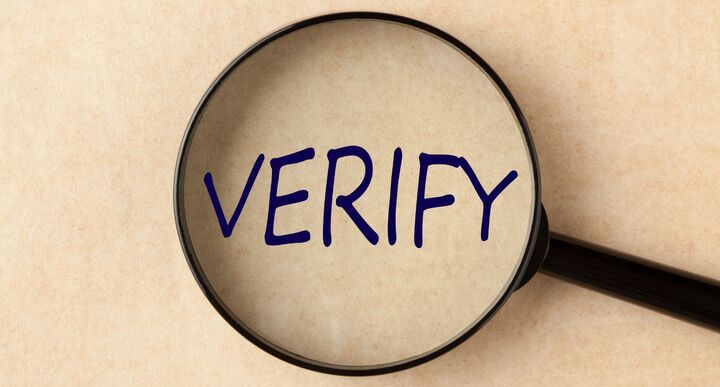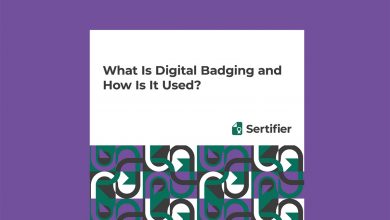Exploring Verifiable Digital Badges
Table of Contents
Introduction

In today’s digital age, methods of certification and proving competency are changing rapidly. One of the most essential elements of this change is verifiable digital badges, which have begun to replace traditional certificates and increase reliability. This article takes a closer look at the new way of certification and covers verifiable digital badges.
Traditional certificates have a long history of being the primary carrier of certification processes. However, digital transformation and the advancement of technology have revealed the limitations and shortcomings of these certificates. Employers and educational institutions are adopting more reliable, traceable, and customizable documentation methods, like online badges, online certificates and microcredentials.
This is where verifiable digital badges come into play. Badges are tools that digitally document a person’s competencies, achievements, and experiences and reliably present them. In this manner, it will become feasible for people and establishments to proportion their actual international accomplishments and capabilities transparently.
Later in the article, we will take a deeper look at verifiable virtual badges and talk about how this technology works, the position of blockchain generation, how it compares to traditional certificates, and how it is effective in many regions, from higher training to business training. Let’s circulate directly to the following sections of our article to discover how consider is a crucial element in this virtual age.
Understanding Verifiable Digital Badges

The advent of the digital age has radically changed the methods of certification and proving competence. A vital component of this change is the rise of verifiable digital badges. In this section, we will focus on understanding what verifiable digital badges are, how they work, and why they are essential.
What are Verifiable Digital Badges?
Verifiable digital badges are digital symbols that represent individuals’ specific skills, achievements, and experiences online. These badges indicate that a person has a particular skill or has completed a thorough training. For example, a student who completes a language course can document this success through a digital badge. Each badge contains a set of metadata, which includes details such as the content of the badge, date of earning, issuer, and more.
Key Features of Digital Badges
Key features of digital badges include portability, accessibility, and reliability. A person can store the badges he has on a digital wallet or profile and share them whenever he needs them. Additionally, since badges are kept signed by the issuing institution, their reliability is high.
Purposes and Uses of Badges
The primary purpose of badges is to document individuals’ abilities and achievements. However, badges have many different uses. Educational institutions can use badges to recognize and document student achievements. Employers can review badges to understand candidates’ skills and experience better. Additionally, badges can be shared across social platforms and used as part of digital identity creation.
Creating and Issuing Badges
Creating and issuing badges is a process that requires care. Issuing institutions determine the content and standards of badges. When a person earns a badge, the issuing institution digitally signs it and returns it to the owner. One of the most important elements that increase the reliability of badges is this signature. The use of blockchain technology increases the traceability and reliability of badges.
Blockchain Technology and Its Role in Verifiable Digital Badges

The reliability and traceability of digital badges form a cornerstone of this innovative certification tool. A critical technological element that increases this reliability is blockchain technology. In this section, we will examine how blockchain technology interacts with verifiable digital badges and contributes to reliability.
Basic Principles of Blockchain Technology
First, it is essential to understand the basic principles of blockchain technology. A blockchain is an ever-growing record of transactions, and these records are grouped into blocks. Each block contains the contents of the previous block and adds new data on top of the data of the last block. This process ensures that the chain constantly grows and creates a reliable transaction history.
The Connection Between Blockchain and Badges
Verifiable digital badges increase credibility by interacting with blockchain technology. As the winner earns each badge, this winning transaction is recorded on the blockchain. This confirms that the earned badge is valid and traceable. Blockchain networks have a decentralized structure, which increases the reliability of badges because many different nodes verify the information.
How to Ensure Reliability and Traceability?
Blockchain technology supports several essential elements to ensure the reliability of verifiable digital badges. First, this technology makes every transaction traceable, making it easier to verify the authenticity of the badge. Second, blockchain technology increases the credibility of the badge by verifying the identity of the issuing institution. Third, issuers increase the credibility of these badges by signing the dates the badges were issued and other details. Finally, badge holders increase credibility by linking and storing these badges to their digital identities.
The interaction of blockchain technology with verifiable digital badges is an important feature that distinguishes this certification method from traditional certificates. The reliability and traceability of badges enable individuals and institutions to trust this new certification model. Now, let’s move on to the next section to compare verifiable digital badges with traditional certification systems.
Verifiable Badges vs. Traditional Certificates

The rise of verifiable digital badges has led to significant changes compared to traditional certification methods. In this section, we will analyze these two certification methods, comparing the differences and similarities between verifiable digital badges and standard certifications.
Limitations of Traditional Documents
Traditional certificates are paper-based and usually tested using a seal or signature. However, these documents have some barriers. First of all, paper certificates are acknowledged to be susceptible to loss or harm. Additionally, extra security features are needed to guard against fraud, a high-priced and complicated technique. The content of the certificate can not be up to date or modified over the years. Finally, verifying a certificate can regularly take a long term and involve a complex technique.
Comparison of Badges and Traditional Badges
Verifiable digital badges offer some advantages over these limitations. First, badges are digital and, therefore, resistant to physical damage. Additionally, to blockchain technology, the validity and history of each badge can be tracked and validated. The content of the badges may be digitally up to date, retaining them up to date with the addition of recent abilities and achievements. This is particularly precious in a hastily changing global enterprise. Badges are faster and easier to verify because using digital signatures and blockchain increases reliability.
Which is More Reliable and Future-Proof?
This comparison between verifiable digital badges and traditional certifications is critical regarding reliability and future perspective. Standard certificates have a history and are widely accepted but are vulnerable to fraud and physical damage. Verifiable digital badges offer a new approach that increases trustworthiness and traceability but may still need to be widely adopted. But as digital transformation progresses and technology becomes more mature, a future in which badges can replace traditional certificates may be possible.
This comparison helps us understand the advantages and disadvantages of both certification methods. Now, let’s move on to the next section to examine how verifiable digital badges are making an impact in higher education and business.
Verifiable Digital Badges in Higher Education

Higher education, especially universities and colleges, has long evaluated and documented student achievements using traditional certification methods. However, in recent years, verifiable digital badges have triggered a significant shift in higher education and are considered a sign of a paradigm shift.
The Rise of Badge Use in Higher Education
Verifiable digital badges offer a new, more effective method of student assessment for higher education institutions. These badges provide a more detailed evaluation than traditional certifications by digitally documenting students’ specific skills, achievements, and experiences. Students can display these badges to potential employers in their post-graduation job search, thus highlighting particular skills and accomplishments.
Earnings of Universities and Students
Universities and colleges have become more competitive by offering verifiable digital badges to their students. Students can use their badges not only as a paper document but also as a digital identity. This helps them market their skills and experience more effectively as they build their careers after graduation. It is also possible for students to share their badges on social media and other digital platforms, which helps students attract the attention of potential employers.
Changes in Education Systems
Verifiable digital badges lead to changes in education systems to attract more students to higher education and better document the skills and knowledge acquired. Educational institutions can make student evaluations more transparent and reliable by focusing on badges. They can also use badges to provide students with personalized educational experiences.
In this section, we examined how verifiable digital badges led to a paradigm shift in higher education and their impact on the education system.
How Verifiable Digital Badges Are Reshaping Employee Training and Development

In the business world, continuous learning and development are essential for companies that want to gain a competitive advantage and motivate their employees. In this context, verifiable digital badges have triggered a significant transformation in employee training and development, and this transformation has become a factor shaping business education.
The Role of Badges in Business Training
Verifiable digital badges are beginning to replace traditional certifications in business education. Employees can constantly update themselves by earning these badges, especially for those who want to improve their skills and abilities continually. By using these badges, employers can better understand their employees’ skills and experience, which enhances hiring and promotion processes.
Employee Development and Badge Usage
Verifiable digital badges are a versatile tool to support employee development. Employers can more quickly and reliably verify whether their employees have specific skills or certifications. Additionally, badges help employees track their career progress and allow employers to design training programs more effectively. For employees, badges help them document their skills and present them to employers in a more attractive way.
Effects and Examples in the Business World
More and more companies are realizing the business impact of digital badges. The technology sector, in particular, uses digital badges to document employees’ technical skills and gain a competitive advantage. Additionally, collaboration between educational organizations and employers has increased the acceptance and effectiveness of badges.
Conclusion
In this article, we examined the importance and effects of verifiable digital badges under Exploring Verifiable Digital Badges. Verifiable digital badges are digital symbols that have many advantages over traditional certification methods. This technology has led to radical changes in many areas, from education to the business world.
First, we examined the basic concepts of verifiable digital badges in the section titled “Understanding Verifiable Digital Badges. We understand badges, how they work, and why they are essential. Next, in part, Blockchain Technology and Its Role in Verifiable Digital Badges, we learned how blockchain technology interacts with these badges and contributes to trustworthiness.
In the section titled Verifiable Badges vs. Traditional Certificates, we compared the differences and similarities between verifiable digital badges and traditional certificates. Badges provide excellent reliability and traceability and can potentially be the certification model of the future.
In the Verifiable Digital Badges in Higher Education section, where we examined its effects on higher education, we understood how universities and students benefit from this technology. Changes in education systems have helped students better document their skills and build their future careers.
Finally, in the section, How Verifiable Digital Badges Are Reshaping Employee Training and Development, we examined how verifiable digital badges in the business world transform employee development and training. We’ve found that badges improve hiring processes, make it easier to deliver personalized training experiences for employees, and help employers better understand their employees’ skills and expertise.
Verifiable digital badges are a powerful certification tool and will continue to shape the education and certification systems of the future. This technology has revolutionized education and business by providing reliability, traceability, and personalization. Badges will be essential in building a trust-based digital future and will become more accepted. We must closely monitor the potential of this technology to anticipate that future certification and training processes will include more verifiable digital badges.



